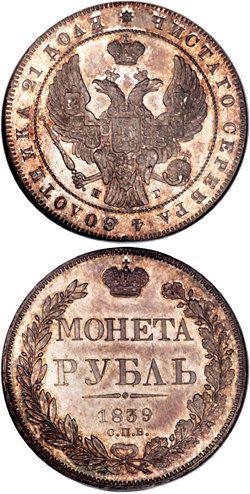By Dr. Sol Taylor
"Making Cents"
Saturday, July 21, 2007
| P |
The Heritage Auction Galleries sale during the Central States Convention in St. Louis on May 10-11, 2007, logged total sales $17,575,465. A few selected highlights in that sale: A 1776 Continental dollar in pewter, graded Mint State-64, realized $161,000; a stellar 1927-S Standing Liberty quarter, MS-65, full head, also fetched $161,000; an 1895 Morgan dollar, graded PR-67 Ultra Cameo, brought $103,500; an 1858 $10 gold piece, graded MS-64, went for $276,000; a 1797 $10 gold piece, MS-63, realized $109,250; A $4 Stella, flowing hair type, certified PR-66 Cameo, went for $253,000.
|
In the foreign section, a gold Brazil 1734-R 6,400 reis brought $37,575. A Russian 1908 proof rouble realized $37,375. The highlight coin in the sale, a Russian Nicholas I proof rouble dated 1839, graded PR-66, realized $264,500.
In the past 20 years or so, collectors who have amassed select rare coins have offered their collections through the major auction houses, and at each sale, many records were set and old records have fallen. In the American Numismatic Association sale of 1967, Aubrey Beebe, an Omaha coin dealer, paid the astounding price of $46,000 for one of the five known 1913 Liberty head nickels. The coin has since been donated to the ANA’s Edward C. Rochette Money Museum after Beebe died several years ago. One of the other five pieces sold recently for $5 million in a private (non-public auction) transaction.
The attraction of a major auction lies in the fact that many of the coins have been out of marketplace for decades, and today’s well-financed collectors and even institutions are ready to acquire some of these long-hidden treasures at almost any cost
In addition, many collectors vie with each other for Registry Set-quality coins — a phenomenon that started about 15 years ago when Professional Coin Grading Service started to list collections that held the highest-graded coins. Collectors in the past often vied for top status of their collections, and that was evident in the book, "Penny Whimsy," by Dr. William Sheldon. Collectors of early American coppers would often meet and put their top-quality coins on a table to determine who had the best of each date and type. Coins were then rated as Best, No. 2, No. 3, etc. The status gave the coin great value in a sale.
Today, with inflation and currency variations, many collectors, institutions and investors are looking at rare coins for future security and appreciation. The charts showing auction results reflect dramatic price increases for almost every series of coins from ancients to modern, but most dramatic among certified U.S. coins graded MS-65 (or PR-65) and above.
The addition of certification, starting with ANACS in 1975 and then slabbing (encapsulation) in 1985, has added value to coins, because before then, grading was often very arbitrary. Many coins graded as "Brilliant uncirculated" before 1970 later became MS-63 or MS-66 once slabs were in common use. Since the price differences between "Uncirculated" and "BU" were not very significant at the time, many older catalogs took little effort to fine-tune the distinctions. Many coins that were sold 50 years ago with one grade have a different grade today — sometimes higher, but more often lower than before.
Generally speaking, an estate or collection with coins valued at $100,000 or more are best suited for a major auction, usually held in conjunction with a regional coin convention. The floor bidders, online bidders and mail-in bidders often combine to add luster to the sale, and many coins reach record highs as a result. For information on upcoming auctions by Heritage, the largest coin auction house, visit HA.com.
Dr. Sol Taylor of Sherman Oaks is president of the Society of Lincoln Cent Collectors and author of The Standard Guide to the Lincoln Cent. Click here for ordering information.
©2007 SCV COMMUNICATIONS GROUP & SOL TAYLOR · ALL RIGHTS RESERVED.

![[Most Recent Quotes from www.kitco.com]](http://www.kitconet.com/images/quotes_special.gif)

